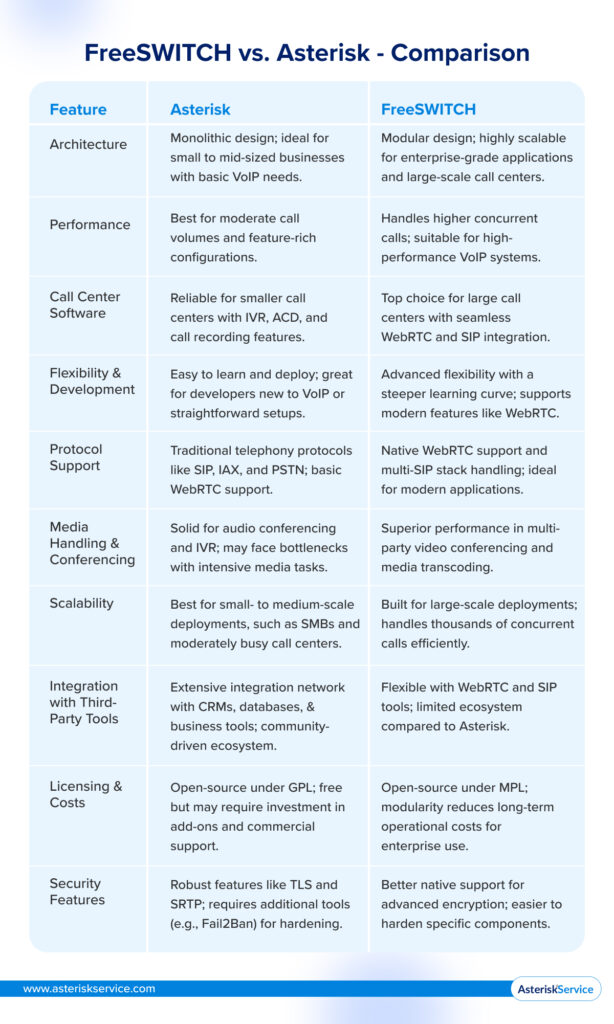
Two names stand out in the open-source world of VoIP when it comes to powering your communication systems: FreeSWITCH and Asterisk. But which one is better suited for your needs? This question has sparked countless debates among developers, businesses, and IT teams. Whether you’re building a robust FreeSWITCH call center, scaling VoIP solutions, or searching for an alternative to Asterisk, choosing between Asterisk and FreeSWITCH can be a monumental decision.
Let’s break it down step-by-step, so you can confidently decide which fits your unique requirements. If you’re diving into Asterisk development, a business exploring FreeSWITCH for VoIP development, or simply curious, this blog helps you to cover all the aspects.
Why Compare Call Center Software Asterisk and FreeSWITCH?
At their core, FreeSWITCH and Asterisk share a common goal: enabling flexible, feature-rich communication systems. Both are competent platforms with open-source roots, but their architecture, focus areas, and performance can make one a better fit than the other based on your specific use case. Comparing FreeSWITCH vs Asterisk is critical to understanding how their performance differs based on use cases like FreeSWITCH call center deployment or call center software Asterisk implementation.
Instead of seeing them as competitors, consider them two specialized tools. Choosing the right one means understanding their strengths and weaknesses. Whether you’re interested in call center software Asterisk or FreeSWITCH call center capabilities, the choice depends on scalability and needs.
Key Differences Between FreeSWITCH and Asterisk
Here are some points specified by FreeSWITCH and Asterisk that suit them the best.
Architecture: Modular vs. Monolithic
- Asterisk Monolithic Design: Asterisk operates as a monolithic system, meaning all its features run as part of a single core. While this design makes setting up and deploying for more straightforward tasks easier, it can become less efficient as you add more complex features. This design works beautifully for small- to mid-sized businesses looking for call center software Asterisk or FreeSWITCH basic VoIP functionality.
- FreeSWITCH Modular Design: FreeSWITCH, on the other hand, is designed to be modular. It allows developers to load only the needed features, keeping the system lean and efficient. It makes FreeSWITCH development highly scalable and better suited for enterprise-grade applications like high-performance VoIP systems or FreeSWITCH call centers.
If simplicity and ease of use are your priorities, Asterisk for VoIP development takes the lead. But if scalability and customization matter more, FreeSWITCH is the better choice.
Performance
When it comes to FreeSWITCH vs Asterisk performance, the modular architecture of FreeSWITCH gives it a distinct advantage. FreeSWITCH can handle a significantly higher number of concurrent calls than Asterisk, making it the go-to solution for businesses needing enterprise-grade FreeSWITCH call center software.
However, Asterisk shines in environments with moderate call volumes and a focus on feature-rich configurations rather than raw performance.
- Use Case for Asterisk: Small- to mid-sized businesses looking for an all-in-one VoIP solution, including reliable call center software Asterisk.
- Use Case for FreeSWITCH: Enterprises requiring high-performance VoIP systems with the ability to handle thousands of concurrent calls, making it ideal for FreeSWITCH call center scenarios. For high concurrency and performance-heavy applications, FreeSWITCH leads. However, for moderate use cases, Asterisk performs admirably.
Call Center Software
Both Asterisk and FreeSWITCH are popular choices for call center software, but their approach is different:
- Asterisk for Call Centers: Asterisk has been the backbone of many call center software Asterisk solutions for years. Its extensive features for interactive voice response (IVR), automatic call distribution (ACD), and call recording make it a fantastic choice for building reliable and cost-effective call center solutions.
- FreeSWITCH for Call Centers: FreeSWITCH’s modular design and high scalability make it a top pick for FreeSWITCH call centers handling large call volumes. It integrates seamlessly with WebRTC and SIP solutions, ensuring smooth functionality for modern FreeSWITCH for VoIP deployments.
Asterisk suits smaller call centers with feature-focused needs, while FreeSWITCH dominates in high-volume scenarios.
Flexibility and Development
If you’re a developer looking to build custom VoIP systems, here’s what you need to know:
- Asterisk Development: Asterisk is highly feature-rich and supports a wide range of telephony protocols. The learning curve is relatively gentle, making it ideal for developers new to Asterisk for VoIP development or businesses with straightforward requirements.
- FreeSWITCH Development: FreeSWITCH offers more flexibility and advanced features, such as native WebRTC support and better video conferencing handling. However, this flexibility has a steeper learning curve, which may not suit beginners.
Choose Asterisk for simplicity and quick setups and FreeSWITCH for advanced and future-proof VoIP development.
Protocol Support: SIP, WebRTC, and More
FreeSWITCH leads with native WebRTC and multi-SIP stack support, while Asterisk is more traditional but highly reliable.
- Asterisk for Protocol Assistance: Asterisk supports traditional telephony protocols such as SIP, IAX, and PSTN, making it particularly well-suited for building SIP-based VoIP systems. However, while Asterisk supports WebRTC, its implementation is not as natively advanced as FreeSWITCH’s.
- FreeSWITCH for Protocol Assistance: FreeSWITCH stands out for its native support of WebRTC, making it an excellent choice for modern applications such as browser-based video calling and real-time communications. It also supports multiple SIP stacks simultaneously, which adds flexibility for VoIP developers.
FreeSWITCH wins here, especially for projects requiring WebRTC integration or advanced protocol handling.
Media Handling and Conferencing
FreeSWITCH outshines Asterisk with superior video conferencing and media handling capabilities.
- Media Handling Asterisk: Asterisk provides solid support for audio conferencing, IVR, and media streaming. However, its monolithic architecture can lead to performance bottlenecks when handling intensive media tasks such as video conferencing or transcoding.
- Media Handling FreeSWITCH: FreeSWITCH was designed with media handling in mind. Its modular approach improves performance during heavy media processing, including multi-party video conferencing and media transcoding. It makes it ideal for projects requiring complex media setups or video-based communication.
FreeSWITCH is the preferred choice for advanced media handling and conferencing.
Scalability: Small vs. Large Deployments
Asterisk suits small to medium businesses, but FreeSWITCH is built for large-scale systems.
- Asterisk Scalability: Asterisk performs well in small- to medium-scale deployments, such as small offices, SMBs, and moderately busy call centers. However, its monolithic design limits scalability for high-demand systems, especially those requiring thousands of concurrent calls.
- FreeSWITCH Scalability: FreeSWITCH is highly scalable and can handle thousands of concurrent calls, making it the go-to solution for large-scale deployments such as telecom-grade services or enterprise call centers.
FreeSWITCH dominates large-scale, high-demand systems.
Integration with Third-Party Tools
While FreeSWITCH provides flexibility for contemporary, customized solutions, Asterisk boasts a more extensive network of integrations.
- Asterisk Integration: Asterisk seamlessly integrates modern communication with popular CRMs, databases, and other business tools. Its community-driven ecosystem means a vast library of add-ons and plugins is available for everyday use cases.
- FreeSWITCH Integration: FreeSWITCH offers excellent integration capabilities, especially with WebRTC client solution development, applications and SIP-based tools. However, the ecosystem for FreeSWITCH integrations isn’t as extensive as Asterisk’s, making development slightly more challenging for specific use cases.
Asterisk has an edge for businesses needing off-the-shelf integrations, while FreeSWITCH excels for custom, cutting-edge solutions.
Licensing and Costs
- Asterisk Licensing: Asterisk is open-source software licensed under the General Public License. While it’s free, businesses often need to invest in add-ons, plugins, or commercial support for specific features.
- FreeSWITCH Licensing: FreeSWITCH is licensed under the Mozilla Public License, which offers slightly more flexibility for developers working on proprietary projects. Additionally, FreeSWITCH’s modular architecture may reduce long-term operational costs by enabling you to load only the features you need.
FreeSWITCH may be more cost-effective for enterprise-level or proprietary use cases, while Asterisk is affordable for general deployments.
Security Features
- Asterisk Security: Asterisk offers robust security features such as TLS and SRTP for encrypted calls. However, its relatively simpler design can leave it vulnerable to brute-force attacks unless adequately secured with tools like Fail2Ban and other security measures.
- FreeSWITCH Security: FreeSWITCH provides equally robust security options with better native support for advanced encryption protocols. Its modularity also makes it easier to harden specific system components without impacting the entire deployment.
FreeSWITCH edges ahead for enterprise-level security, but Asterisk performs well with proper security configurations.
FreeSWITCH vs. Asterisk — Comparison
Here’s a comparison table that highlights the critical differences between Asterisk and FreeSWITCH:

The Final Verdict
So, FreeSWITCH vs. Asterisk? The answer depends on what you need:
- Choose Asterisk: If you want a simple, feature-rich VoIP solution that’s easy to set up and manage. It’s perfect for small to mid-sized businesses and developers just starting with VoIP development.
- Choose FreeSWITCH: If your priorities are scalability, high performance, and advanced features like WebRTC. It’s the ultimate solution for enterprise-grade projects and large call centers.
Both Asterisk and FreeSWITCH are potent platforms with distinct strengths. Your choice ultimately depends on your business needs, technical expertise, and scalability requirements. If you’re unsure, contact our Asteriskservice experts, who can help tailor the right solution.
FAQs
What is the primary difference between Asterisk and FreeSWITCH?
The main difference lies in their architecture. Asterisk is a monolithic framework, whereas FreeSWITCH follows a modular architecture where each feature is a separate module, allowing it to handle large-scale deployments more efficiently.
Which platform is better suited for small-to-medium businesses?
Asterisk is mainly for small-to-medium businesses because of its more straightforward setup, robust documentation, and strong community support. It is ideal for use cases like small call centers, IVR systems, or basic VoIP systems that do not require heavy scalability.
Is FreeSWITCH better than Asterisk for handling concurrent calls?
FreeSWITCH is generally better at handling many concurrent calls due to its modular design and efficient use of system resources. It is excellent for large-scale deployments like multi-tenant VoIP systems or telecom carriers.
Can Asterisk and FreeSWITCH be used together?
Absolutely! Many organizations use Asterisk and FreeSWITCH together to leverage the strengths of both platforms. For example, Asterisk can handle signaling (e.g., SIP registration), while FreeSWITCH manages media processing for large-scale, high-quality call handling.
Which platform is more straightforward to configure for developers?
Asterisk is often considered more beginner-friendly due to its straightforward configuration. However, FreeSWITCH offers more flexibility and developers are familiar with its modular setup. The choice depends on the developer's familiarity with the project's complexity.